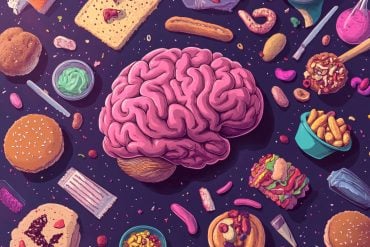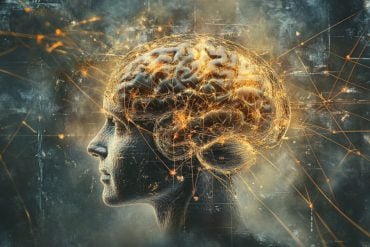Summary: A new study has found that people with a genetic risk for psychosis have an imbalance of glutamate and GABA neurotransmitters in their brains, specifically in the hippocampus. This imbalance is associated with hippocampal atrophy, which may lead to the development of psychotic symptoms.
The findings could lead to new treatments for psychosis by targeting the glutamate-GABA imbalance.
Key Facts:
- People with a genetic risk for psychosis have an imbalance of glutamate and GABA neurotransmitters in their brains.
- This imbalance is associated with hippocampal atrophy, which may lead to the development of psychotic symptoms.
- The findings could lead to new treatments for psychosis by targeting the glutamate-GABA imbalance.
Source: Elsevier
Dysregulation of the dopamine neurotransmitter system has long been associated with schizophrenia and other forms of psychosis, but recently researchers have begun to examine the glutamate and GABA systems as well.
Studies have shown that an excitatory-inhibitory imbalance begins with improperly functioning NMDA-type glutamate receptors (NMDAR) in temporal regions of the brain, but much of the evidence comes from studies of the brains of psychotic people, leaving in question whether the imbalance results from psychotic symptoms or precedes them.
Now, a new study in people with the copy variant number 22q11.2 deletion syndrome (22q11DS) probes the excitatory-inhibitory neurotransmitter system prior to the onset of psychosis.
Deletion carriers have a strong predisposition for psychiatric illnesses including anxiety and mood disorders, and they have a 30% lifetime risk of developing psychotic disorders, including schizophrenia, by adulthood.
These carriers present a unique opportunity for longitudinal studies on neuropsychiatric illnesses because of the possibility of study and follow-up before and after the onset of such illnesses.
The study appears in Biological Psychiatry, published by Elsevier.
Researchers led by Valentina Mancini, PhD, at the University of Geneva School of Medicine, used magnetic resonance imaging (MRI) together with proton magnetic resonance spectroscopy (MRS) to estimate levels of the excitatory neurotransmitters glutamate and glutamine (Glx), and the inhibitory neurotransmitter GABA in the brains of 60 individuals with 22q11DS and 45 healthy controls.
They focused on three brain regions implicated in schizophrenia pathophysiology: the anterior cingulate cortex (ACC), superior temporal cortex (STC), and hippocampus.
Deletion carriers had higher levels of Glx in hippocampus and STC, but not in the ACC, compared to controls. Carriers also had significantly lower levels of GABA in the hippocampus, but not the ACC or STC.
Importantly, among 22q11DS carriers, those with psychosis also had higher Glx levels in the hippocampus, suggesting that changes in the hippocampus may drive downstream pathology.
Atrophy of the hippocampus has also been observed in the brains of people with schizophrenia. In the current study, Glx concentration was associated with greater atrophy, perhaps pointing to an elevated vulnerability of the hippocampus.
“Our results highlight that temporo-limbic regions, and in particular the hippocampus, undergo a progressive shift in the ratio between the concentration of excitatory and inhibitory neurotransmitters,” said Dr. Mancini.
“Moreover, we found that those individuals with higher levels of excitatory neurotransmitter also had a higher extent of hippocampal volume loss over time. These individuals also started to experience psychotic symptoms, such as hallucinations and delusions.
“Our study provides novel insight into potential mechanisms underlying hippocampal atrophy in individuals at risk for psychosis and links these neural abnormalities to the emergence of psychotic symptoms.”
John Krystal, MD, Editor of Biological Psychiatry, said of the work, “This study of 22q.11 deletion syndrome, a syndrome with increased risk for schizophrenia, elegantly builds on prior findings linking excessive glutamate release to smaller cortical volumes, suggestive of atrophy. This form of atrophy may contribute to cognitive and functional impairments.”
The work may have clinical implications, Dr. Mancini added. “The current findings can inform novel treatment strategies targeting early glutamatergic dysfunction in individuals at risk for psychosis.
Given the essential role of the hippocampus in memory processes, preventing excitatory-inhibitory imbalance and volume loss could potentially mitigate the cognitive decline typically observed in psychotic patients.”
About this psychosis research news
Author: Eileen Leahy
Source: Elsevier
Contact: Eileen Leahy – Elsevier
Image: The image is credited to Neuroscience News
Original Research: Open access.
“Excitatory-inhibitory imbalance underlies hippocampal atrophy in individuals with 22q11.2 deletion syndrome with psychotic symptoms” by Valentina Mancini et al. Biological Psychiatry
Abstract
Excitatory-inhibitory imbalance underlies hippocampal atrophy in individuals with 22q11.2 deletion syndrome with psychotic symptoms
Background
Abnormal neurotransmitter levels have been reported in subjects at high risk for schizophrenia, leading to a shift in the excitatory/inhibitory balance. However, it is unclear if these alterations are predating the onset of clinically relevant symptoms. Our aim was to explore in vivo measures of excitatory/inhibitory balance in 22q11.2 deletion carriers, a population at genetic risk for psychosis.
Methods
Glx (glutamate+glutamine) and GABA+ concentrations were estimated in the anterior cingulate cortex (ACC), superior temporal cortex (STC) and hippocampus using a MEGAPRESS sequence and the Gannet toolbox in 52 deletion carriers and 42 controls. T1-weighted images were acquired longitudinally and processed with Freesurfer v.6 to extract hippocampal volume. Subgroup analyses were conducted in deletion carriers with psychotic symptoms.
Results
While no differences were found in the ACC, deletion carriers had higher levels of Glx in the hippocampus and STC, and lower levels of GABA+ in the hippocampus compared to controls. We additionally found a higher Glx concentration in the hippocampus of psychotic deletion carriers. Finally, more pronounced hippocampal atrophy was significantly associated with increased Glx levels in deletion carriers.
Conclusions
We provide evidence for an excitatory/inhibitory imbalance in temporal brain structures of deletion carriers, with a further hippocampal Glx increase in individuals with psychotic symptoms that was associated with hippocampal atrophy. These results are in line with theories proposing abnormally enhanced glutamate levels as a mechanistic explanation for hippocampal atrophy via excitotoxicity. Our results highlight a central role of glutamate in the hippocampus of individuals at genetic risk for schizophrenia.







